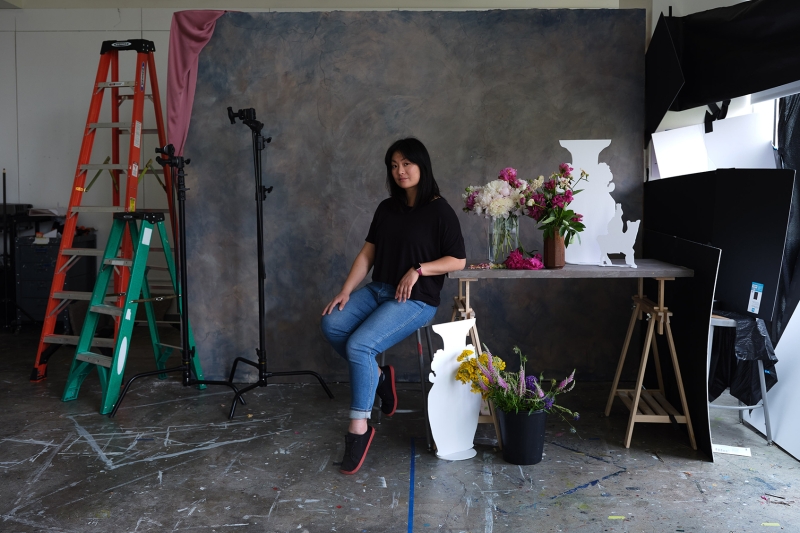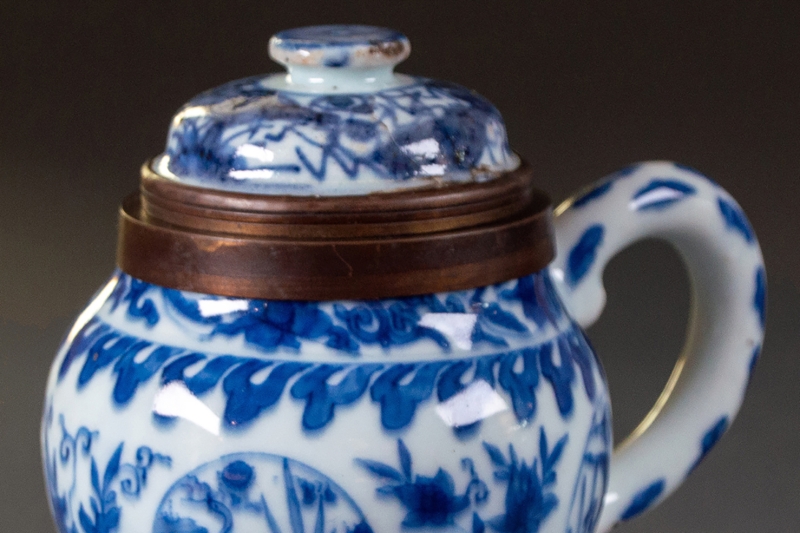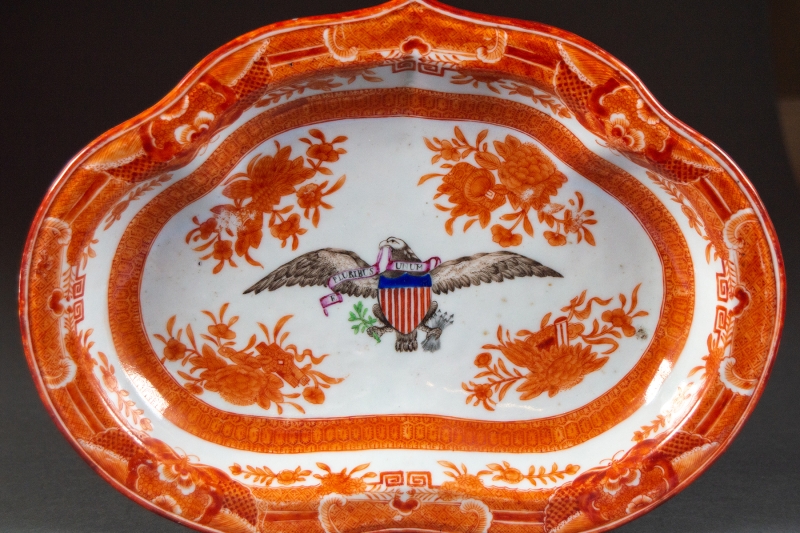Collection Connections Washington and Lee’s Museum Artist-in-Residence Program welcomed photographer Stephanie Shih to campus in May to create new work based on the Museums’ art collection.
“Through this residency project, we hope to inspire more direct engagements with our collection, and an understanding and appreciation of art, history, and culture.”
~ Isra El-beshir, director of the Museums at W&L
Visitors to the McCarthy Gallery, located inside Washington and Lee’s Holekamp Hall, were treated to lush still life photographs evoking elaborate Dutch 17th-century paintings, densely populated with flowers, courtesy of Los Angeles-based artist Stephanie Shih during Asian American and Pacific Islander Heritage Month in May.
What those viewing Shih’s playful compositions might not have known was that across campus, Shih was simultaneously creating a new body of still life photography inspired by the Museums at W&L’s art collection of export porcelain as part of a new artist-in-residence program. During Spring Term, Shih completed a residency on campus photographing objects drawn from Museums’ collection of Chinese export porcelain, combining the objects with archival materials, native plants from the surrounding area, and her own personal narrative. The results of the project will culminate in a new exhibition called “LONG TIME NO SEE 好久不見,” opening during the summer of 2024 in the Reeves Museum of Ceramics and continuing through the spring of 2025.
The Museum Artist-in-Residence Program, made possible by the Reeves Endowment Fund, is the first program of its kind for the Museums at W&L. Isra El-beshir, director of the Museums at W&L, said her goal is to ensure the collection remains a relevant resource to Washington and Lee’s rich intellectual life, and developing the residency program offered an opportunity to reflect on ways to increase the criticality of interpretation of items in the collection, encourage what she calls “historical empathy,” and connect objects in the collection with the present moment.
“Shih’s residency project introduces new knowledge and fresh perspectives to our collection through a new body of still life photography that directly intervenes with the histories of the ceramics export and Asian American experiences, revealing the colonial underpinnings and tensions inherent in both narratives,” El-beshir said. “Through this residency project, we hope to inspire more direct engagements with our collection, and an understanding and appreciation of art, history, and culture.”
El-beshir said the desire to create an artist residency program, which is by invitation only, was spurred by discussions over two years with students, staff, and faculty. Those conversations highlighted a need for the Museums to reexamine its educative goals, collecting practices and curatorial objectives.
Shih is the artist-in-residence program’s inaugural artist, although not the first artist to participate in a residency on campus. In 2009, the Staniar Gallery invited a contemporary Japanese potter, Hoshino Satoru, for an exhibition and artist residency. Satoru gifted the Museums two glazed pieces, titled “Spring Snow,” that he made during his residency. In 2018, the Center for Global Learning invited Dr. Ling-ting Chiu, a Fulbright Scholar and history professor at Soochow University in Taiwan, for a summer residency to research the impact of traditional Chinese artists, focusing on the university’s collection of artwork by artist and former W&L professor of art, I-Hsiung Ju.
“This opportunity was so exciting for me,” Shih said. “How often do you get to work with historical objects with such interesting cultural histories, weaving together these stories from Asia, Europe and the U.S. with contemporary experiences?”
The Museums’ art collection, which consists of roughly 6,000 ceramics made between 1500 and 1900, is best known for its Chinese export porcelain made for the European and American markets, and arguably the fifth largest collection in the United States. Shih’s exhibition will also incorporate a painting by 20th-century American painter Louise Herreshoff Reeves that Shih plans to have displayed “in conversation” with work she created while on campus. Elizabeth Spear, curator of academic engagement for the Museums at W&L, said the work Shih created while on campus will offer visitors to the forthcoming exhibition many layers to explore.
“The stories behind these objects are complex, and of course, Lexington’s history is so rich and complex — and then Stephanie brings her own personal story as a member of the Asian diaspora and a second-generation Taiwanese Chinese American, as well as her identity as an academic and linguistics professor,” Spears said.
Shih’s photography explores themes of contemporary and historical cultural dynamics of the Asian American diaspora through still-life photography. Her work has been exhibited in solo and group shows at venues including Hashimoto Contemporary (L.A.), Griffin Museum of Photography (Boston), USC Pacific Asia Museum (Pasadena), and The Royal Photographic Society (UK). Shih’s photography has been featured in outlets including 7×7, Elle Girl Korea, Gastronomica, Bloomberg Businessweek, Buzzfeed and Los Angeles Times. Shih earned a Ph.D. in linguistics from Stanford University and is a professor at the University of Southern California.
According to Shih, a key aspect of her W&L residency work was weaving together the narratives of the objects with Lexington and Rockbridge County.
“Working with the collection led me to consider where the biographies of the objects intersect with the biographies of the people that surround them,” Shih said. “If we think of these objects as members of the diaspora, they’ve lived an entire life before arriving in southwest Virginia.”
Shih worked closely with multiple departments during her time on campus. The IQ Center assisted with some aspects of the project, and the Office of Sustainability was instrumental in providing expertise in identifying non-native plants that were incorporated into some of the photographs. Shih also welcomed students to visit the studio and talk about the project in the context of their coursework in coordination with faculty from the department of art and art history.
After a visit to Professor Christa Bowden’s art class in February as part of her preparatory work, Shih was connected to Linh Ngo ’26, who later served as her studio assistant throughout the residency. Ngo, a prospective psychology major and education minor from Vietnam, assisted Shih with everything from gathering materials to building the backgrounds of the photos that will be in the exhibition next year. Ngo is currently interning for a magazine in Vietnam and said this experience, along with her photography courses, uncovered a new passion for her.
“I had no idea I enjoyed photography this much before arriving at W&L,” Ngo said. “Working in the studio as an assistant was definitely the best choice I could have made for myself during my first year.”
Ngo worked closely with Shih and Spear in learning how to handle objects from the collection as Shih created the compositions, an experience that Ngo said offered her insight into the collection’s history and the care taken to preserve it. The Museums will be planning future student engagement with the exhibition and its program schedule throughout the coming academic year, and Ngo looks forward to having the wider campus community finally see the work on display.
“Considering the Museums is a department that serves the pedagogical needs of our university, we aim to empower and deepen student experiences by providing engaged learning opportunities during the residency and exhibition,” El-beshir said. “Our main goals of the residency are for artists to enrich the intellectual and cultural life of W&L and produce new interpretative frameworks that help us better examine questions that shape our histories, communities, and cultures.”
 Inaugural Museum Artist-In-Residence Stephanie Shih in Wilson Hall
Inaugural Museum Artist-In-Residence Stephanie Shih in Wilson Hall This mustard pot, made in China between 1630-1644, was incorporated into one of Shih’s photographs.
This mustard pot, made in China between 1630-1644, was incorporated into one of Shih’s photographs. This porcelain dish was made between 1810-1820 and is one of the pieces included in the 2024 exhibition.
This porcelain dish was made between 1810-1820 and is one of the pieces included in the 2024 exhibition.
You must be logged in to post a comment.